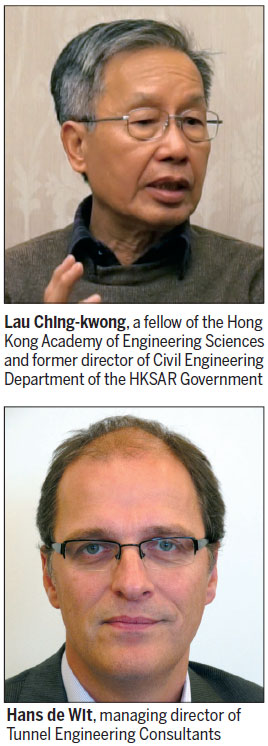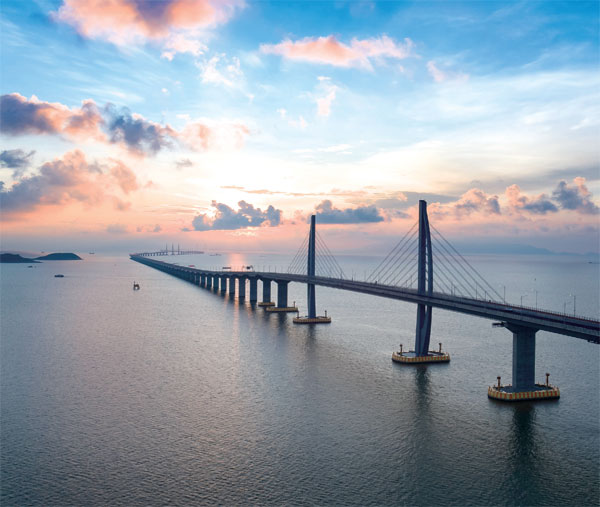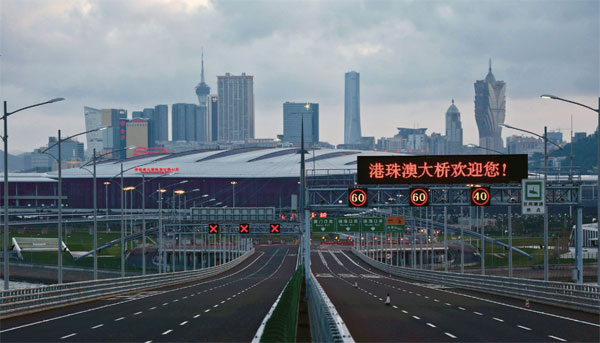Complex geology leads to a technical marvel
Updated: 2018-10-23 07:45
By He Shusi(HK Edition)
|
|||||||
Experts say the many difficult challenges posed by such an ambitious project also encouraged great innovations, He Shusi reports.
The complex geology of the Pearl River Estuary in south China was a driving force behind the technological innovation that makes the Hong Kong-Zhuhai-Macao Bridge stand out over all similar projects in the world, say experts.
The experts in civil engineering point to variable soil conditions with thick layers of soft alluvial clay in the Pearl River Estuary. Sometimes it was very soft. The undersea tunnel with a depth of about 50 meters was subject to high hydraulic pressure. The long span of 55 kilometers makes the bridge the world's longest to date. In sum, HZMB may be the most complex and challenging sea crossing ever built, experts said.
|
The making of the Hong Kong-Zhuhai-Macao Bridge has been more difficult than some of the other world-class sea bridge project mainly due to its unfavorable geological conditions. HZMB Authority / For China Daily |
Hans de Wit, managing director of Tunnel Engineering Consultants, one of the world's leading companies in tunnel construction in the Netherlands, said complicated infrastructures like HZMB typically stimulate innovation.
De Wit is the lead consultant for the design and construction of HZMB's island and tunnel project. He has nearly 30 years of experience in immersed tunnel projects.
The size of the HZMB project, including its immense budgets, allows for study and innovation, de Wit said. "Additionally, these large infrastructure projects very often contain technical challenges beyond the current state of the art. This is also the case with HZMB."
HZMB presented outstanding examples of how challenges initiate innovation in technologies, de Wit said.
Battle with the seabed
The 6.7-km tunnel of HZMB is currently the world's longest immersed tunnel for road traffic. It is China's first offshore immersed tunnel, and the most technologically challenging part of the whole project.
Since the tunnel is placed on a 20-meter deep trench along the seabed, the soil conditions of the seabed determine whether the tunnel has a solid and stable foundation.
In the case of HZMB, the tunnel is constituted of 33 tunnel elements, so there are dozens of joints between each element. Hence, each unexpected subsidence of a near 80,000-ton tunnel element due to an unstable foundation, could destroy the whole undersea structure.
Different from similar projects in Korea and Denmark, where the tunnels are across straits with relatively stable geology, HZMB is located in an estuary. The scour of the Pearl River brings the estuary silt and soft soil. The loose sediment is variable and easily affected by wave and tide, which makes the seabed quite unstable.
As a result, the construction team decided to install an extra man-made rock block layer that is 2 meters thick under the tunnel base, as an addition to the 1.3-meter layer of traditional gravel bed.
De Wit said the additional rock block is to improve the uniformity of the tunnel foundation, and to keep subsidence of the structure within an acceptable range.

Internationally, settlements of an immersed tunnel need to be within 20 centimeters. But that of HZMB has been controlled within 10 centimeters, according to the bridge's chief engineer Su Quanke.
In the face of the soft and variable seabed in the estuary, the team not only improved it, but also made use of it. To ensure a fast construction of the artificial islands in the special soil conditions, the team created an innovative method, to build an offshore watertight environment using 120 sets of big steel cylinders.
Each steel cylinder is about 40 to 50 meters in length, and 22 meters in diameter. They were embedded into the seabed by special vibrators, and linked end by end to cut off seawater, and form a cofferdam for the land reclamation of the island.
The soft soil conditions are generally challenging for offshore land reclamation, but actually quite favorable for the installation of the cylinders, de Wit said. The penetration into the soft soil by the steel cylinder, especially in the top 5 to 10 meters, went very smoothly and accurately, he said.
"...it is a perfect example where design and construction are nicely balanced to create the optimum solution for the HZMB project with its specific conditions."
Conventionally, seawalls are constructed on firm foundations by replacing the soft marine mud in the seabed by sand fill. This process requires dredging and dumping of a large amount of soft marine mud.
The new method of HZMB helped build two 100,000-square meter artificial islands in 215 days, shortening the marine construction time by about two years than traditional method. It also minimized the impact to marine ecology, by reducing the amount of dredging and dumping of marine mud.
Tough weather
In south China, tough weather such as frequent typhoon and rainstorm, especially in the summer, raises challenges for offshore construction. Hence, each day saved could reduce risks of the project.
The 55-km bridge-island-tunnel complex withstood the strike of strong tropical cyclone Hato in August last year, when the project was still under construction, and the Mangkhut in September, with a maximum gust of over 200 kilometers per hour. These two strong typhoons claimed more than 10 lives in China, and cost the country billions of yuan in economic losses.
"Looking at approximately 14 years of preparation and construction of the project under these challenging conditions, the result is very impressive and will make everybody who contributed to the project very proud. The HZMB project really stretched the limits of immersed tunneling," de Wit said.
"China has all the potential to become one of the leading countries in immersed tunnel projects."
There are fewer than five immersed tunnels in the world longer than three kilometers. Few countries have mastered key technologies. The countries that hold the keys include the Netherlands, the United States, Japan, and now China.
A massive undersea effort such as the HZMB tunnel also requires that a country have the ability to manufacture giant equipment for offshore construction, the productivity for millions of tons of concrete and steel, in a relatively short period - the longer the construction, the higher the cost.
Pressure is an enemy
Also speaking highly of the project, Lau Ching-kwong, a prominent bridge expert in Hong Kong, and a fellow of the Hong Kong Academy of Engineering Sciences, said it was very technologically challenging to consecutively install 33 tunnel elements end to end with a depth of nearly 50 meters beneath the sea, considering the great hydraulic pressure.
To keep the tunnel watertight under the challenging conditions, an innovative structure called "semi rigid" is applied. It changes the traditional proportion of steel bar and concrete of the tunnel element, to improve the water tightness performance of the tunnel as well as making the project more cost-effective.
As a member of the expert group of the HZMB who advised on technologies, Lau thought the fact that the tunnel is perfectly watertight so far makes it stand out from similar projects.
Echoing Lau's views, Peter Lee Kai-kwong, dean of the Faculty of Science and Engineering at Chuhai College of Higher Education in Hong Kong, introduced that traditional structures of a tunnel element are either flexible or rigid.
The semi rigid structure combines both the water tightness and tension of a rigid element, and the flexibility and cost effectiveness of a flexible element. This makes the transport and the installation of the tunnel elements easier to control, and ensures its water tightness, said Lee, who's also a member of the expert consulting group for HZMB.
He believes HZMB has accumulated precious experience for similar projects in the future, and presented many innovative solutions to upgrade the world's tunnel engineering technologies.
The under-construction Shenzhen-Zhongshan Link across the Pearl River Estuary is a perfect example. Based on technologies, marine data, talents and all the other experience from HZMB, the new link is also a bridge-island-tunnel complex, about 40 kilometers to the north of HZMB.
As the first sea crossing in the estuary, HZMB not only links different communities as one, but also breaks the ice for future massive marine engineering in the area - challenges under the complex geology of the Pearl River Estuary are no longer unsolved puzzles.
Contact the writer at heshusi@chinadailyhk.com
|
Roads on the Hong Kong-Zhuhai-Macao Bridge lead to Zhuhai and the Macao Special Administrative Region. HZMB Authority / For China Daily |
(HK Edition 10/23/2018 page11)

